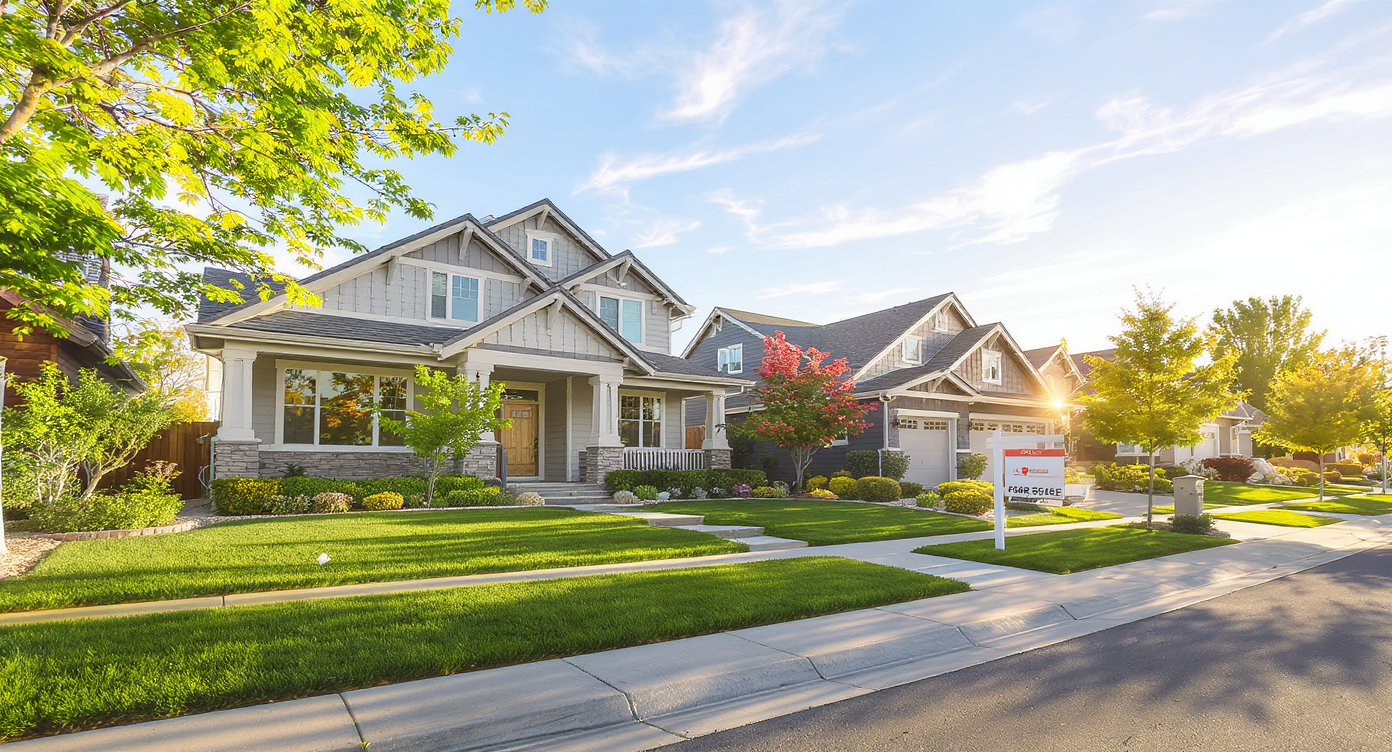TL;DR
Mortgage rates have slipped to about 6.19% for 30-year loans, the lowest in over a year, with 15-year averages near 5.44%. Expect a modest lift in home sales, more refinancing interest, and a sharper focus on pricing, concessions, and presentation to win buyers.
Lede / Opening Context

Optimistic interiors reflect the cautious hope stirring in today’s evolving housing market.
SEO intro: Mortgage rates at a year-low are nudging buyers back and giving sellers a second wind—but savvy strategy still separates the winners.
Mortgage Rates Dip to 6.19%: How a Year-Low Could Rewire 2025 Home Buying, Selling, and Refinancing
Rates are easing, showings are stirring, and strategy matters again. Here’s what today’s real estate market shift means for buyers and sellers.
Housing anxiety is giving way to cautious optimism. The average 30-year mortgage rate has eased to roughly 6.19%, the lowest level in more than a year, while the 15-year sits near 5.44%, according to weekly lender surveys that track the market. For a housing sector that’s slogged through two years of high borrowing costs, this drop lands like a pressure release—and a test of patience.
Here’s the thing: lower mortgage rates don’t flip the market overnight. But they shift the math just enough to revive stalled plans, from first-time buyers considering a starter home to homeowners finally eyeing a refinance. Alt text for listing visual: For Sale sign in a Portland neighborhood, signaling renewed buyer interest as rates dip to 6.19%.
National Data Insight: Mortgage Rates and Momentum
“Rates under 6.25% tend to unlock more touring and offers,” agents often say, and early fall activity is behaving like it. Weekly datasets show the 30-year fixed at about 6.19% and the 15-year at 5.44%, while refinancing now accounts for roughly 56% of applications—small shifts that add up. Industry trackers note purchase and refi apps dipped about 0.3% week over week, but composition changed in favor of refinancing as homeowners chase lower payments.
Mortgage rates generally track the 10-year Treasury yield, which has hovered near ~4% amid expectations of additional central bank cuts and softer labor trends. Even so, economists caution that persistent inflation and policy uncertainty can cap how far mortgage rates fall in the near term. One quotable takeaway: “Rate cuts help, but the bond market’s inflation expectations ultimately set the ceiling—and the floor.”
Context matters: the average mortgage rate has stayed above 6% since late 2022. That’s why modest declines now feel meaningful. A half-point drop can add tens of thousands of dollars in buying power or shave hundreds off a monthly payment, depending on loan size.
Anecdote
A Phoenix seller who relisted after a price reset and rate dip offered a 2-1 buydown; the home drew 12 showings in a weekend and a near-ask offer.
Regional & Segment Analysis: Where Demand Responds First
“Markets with tight inventory react fastest when rates dip,” analysts suggest. Supply-constrained tech hubs and inner-ring suburbs often see showing activity pop within one to two weeks of a sustained rate move. Meanwhile, Sun Belt metros dealing with higher homeowners insurance and new-build competition can lag as buyers weigh total cost of ownership.
Consider a pair of composites from the field. In a North Austin suburb, a 3-bed home that sat through August picked up six showings in three days after a price trim and the rate drop; the seller accepted a clean offer with a small closing credit. In coastal Tampa, a similar listing drew interest but buyers still pressed hard on insurance disclosures and roof age—proof that monthly cost, not just rate, now drives decisions.
Home type matters too. Entry-level homes and well-located townhomes tend to move first because a 0.25–0.50 point rate swing has outsized impact on first-time buyers’ debt-to-income ratios. Newer homes with energy-efficient systems also gain an edge as buyers look beyond rate to utilities, insurance, and maintenance—recurring costs that can swing a budget by 10–15% annually.
One quotable line for sellers: “In a 6% world, the best-performing listings are affordable, efficient, and easy to insure.”
Behavior & Market Psychology: What Buyers and Sellers Are Feeling
“I’m seeing ‘resume play’ energy,” a Midwest agent told me. The pause button many buyers hit in midsummer is unpausing as rates retreat—yet caution is still the baseline. Buyers fear missing a window if rates fall further, but they also fear overpaying if prices pop. That tug-of-war keeps negotiations alive and appraisals under scrutiny.
Real-world minis: Maya, who bought at 6.75% in 2023, just refinanced into a 15-year at ~5.5%, trimming years and thousands in interest. She paid modest points, but the break-even was under three years—a tradeoff many owners are reconsidering as rates drift down. Meanwhile, a seller in Phoenix priced ambitiously in July and struck out. Relisted at a data-backed price with fresh staging and a mortgage buydown credit, the home drew a dozen showings the first weekend and a near-ask offer.
Here’s the psychology in one sentence: “Lower rates reduce friction, but transparency on condition and total monthly cost is what closes.” Buyers expect clear inspection reports, realistic pricing, and actionable options (credits, buydowns) to manage payments. Sellers who resist the new math risk stale days on market and price cuts.
Secondary Insight: ARMs, Buydowns, and the New Math of Affordability
“Adjustable-rate mortgages rise when spreads widen,” lenders note, and ARMs recently made up about 10.8% of applications as buyers chase lower initial payments. For well-qualified borrowers who plan to move or refinance within 5–7 years, a properly structured ARM can be a bridge—provided they understand caps, margins, and worst-case resets.
Rate buydowns are back, too. A 2-1 buydown (seller or builder funded) can reduce a buyer’s first-year payment significantly; on a $450,000 loan, that can mean several hundred dollars per month. Experts often recommend weighing the buydown cost—typically ~2% of the loan amount—against alternative credits for repairs or closing costs. Quotable guidance: “If the buyer’s main barrier is payment, a buydown beats a cosmetic concession almost every time.”
Timing also matters. Rate-lock strategy can be the difference between winning and waiting. Many lenders allow a float-down option if rates drop before closing; buyers should ask up front and compare fees. On the refinance side, advisors suggest a conservative rule of thumb: aim for a break-even of 24–36 months or less when factoring points and closing costs.
Visualization Scenario
Alt text: Bright, staged living room with neutral paint and layered lighting that helps buyers visualize move-in. Caption: Virtual staging clarifies scale and upgrades, reducing hesitation.
FAQ
Will mortgage rates drop below 6 percent in 2025?
Many forecasters say mortgage rates could dip below 6% if inflation cools and bond yields stay near 4%, but there’s no guarantee in the real estate market.
Is now a good time to buy a house with mortgage rates at 6.19%?
If your payment fits and inventory matches your needs, buying at 6.19% can be sensible; the best time to buy a house in 2025 is when you’re budget-ready and can negotiate.
Should I refinance now or wait for lower mortgage rates?
Refinance if you can reach a 24–36 month break-even with current rates; how to refinance a mortgage in 2025 starts with comparing points, APR, and a potential float-down.
Are adjustable-rate mortgages smart in today’s real estate market?
An adjustable-rate mortgage can work if you’ll move or refi within 5–7 years and accept rate-reset risk; ARM vs fixed mortgage decisions hinge on caps and timelines.
How do lower mortgage rates affect home prices and home sales?
Lower mortgage rates improve affordability, typically boosting home sales first; price gains follow in tight-inventory areas as listing strategies and demand converge.
Market Outlook & Reflection
“Easing rates are an invitation, not a guarantee,” market analysts like to say. With the 10-year Treasury hovering near ~4% and policymakers signaling more cuts ahead, sub-6% prints are plausible—but not promised—if inflation cooperates. Trade policy, supply chains, and insurance costs remain wildcards.
The emotional truth is simpler. Deals don’t fall apart because a home is unloved; they fall apart when the monthly cost exceeds the comfort zone. If rates keep slipping, expect more refinances and a gradual thaw in home sales, but the best outcomes will still come from precision: right price, right condition, right financing strategy.
Want to move faster than the market? Presentation wins. Tools like ReimagineHome help agents and homeowners virtually stage, test paint and finishes, and visualize renovation options that preempt buyer hesitation before a listing ever hits the MLS.
Practical Takeaways
For Sellers
- Price with the market you have, not the one you remember. Pair a data-backed list price with a clear concession strategy.
- Offer a mortgage-rate buydown when payment, not price, is the buyer’s hurdle. A 2% credit can be more potent than a larger price cut.
- De-risk the deal: pre-inspection, insurance info, recent service records. Transparency can shave days on market.
For Buyers
- Get fully underwritten pre-approval and compare scenarios: 30-year fixed, 15-year, and ARM with caps. Model payments at +0.5% to stress test.
- Ask lenders about float-down locks and total APR, including points. A slightly lower rate with high fees can erase savings.
- Focus on total monthly cost: principal, interest, taxes, insurance, utilities, HOA. Small line items can swing affordability by 10–15%.
.svg)

.svg)














.png)